Why do the leaves of peppers in a greenhouse wither and what to do to save your harvest?
When growing peppers in a greenhouse, gardeners often encounter the problem of leaves curling. This suggests that some mistakes were made during cultivation. By understanding them and eliminating the causes of the disease in time, you can save the harvest. So why? pepper leaves wither in a greenhouse and what to do in this case?
Possible reasons for wilting of pepper leaves in a greenhouse
At the first sign of curling pepper leaves, it is necessary to urgently determine the cause. Many factors can lead to this: incorrect agricultural technology, inappropriate soil composition, stress after planting seedlings in a permanent place in the greenhouse, the presence pests and disease damage.
If the beds are not loosened in a timely manner, a crust forms on the ground, which disrupts the aeration of the root system. The cessation of air access to the roots is indicated by the appearance of the green mass. The leaf blades lose their elasticity, the edges curl towards the central vein.
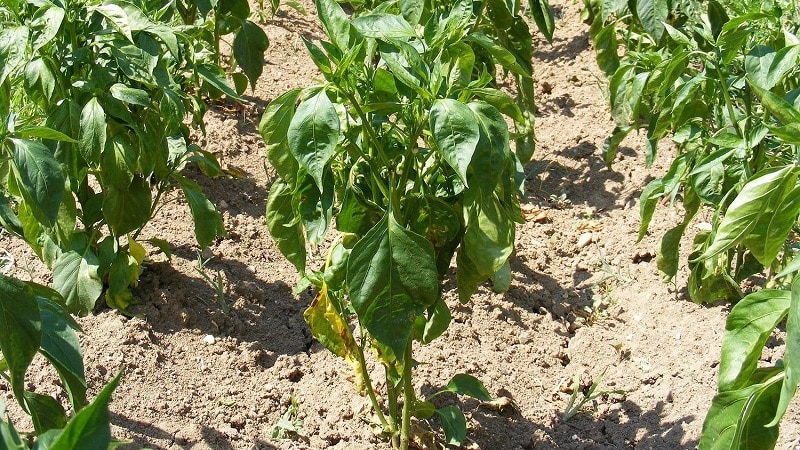
Diseases
The cause of leaf wilting can be the disease phytoplasmosis (stolbor) - a fungal disease provoked by sudden changes in day and night temperatures in conditions of high humidity in the greenhouse. The carriers of the disease are spider mites and aphids. First, the plant becomes covered with red-brown spots and the leaves curl. After irrigation, they lose turgor and rot. The fruits grow small and deformed. Taste qualities are lost.
Late blight, a fungal disease that is also promoted by the humid climate of an enclosed space, may appear in a greenhouse. Small brown spots appear on the leaves. The leaves curl and wither. Black, moist areas appear on the fruits. Gradually the plant dies.
If there are bacteria left in the soil from the previous season, they cause verticillium wilt of pepper. Leaves lose color and become rough and hard. The fruits grow small, deformed, with a small number of seeds.
Fusarium wilt affects the vascular system of the plant. Plaques form in the vessels, clogging them, and the movement of juice stops. The leaves curl and dry out, the bush dies.
Pests
Pepper grown in a greenhouse is not as susceptible to pest damage as in open ground, but some types of harmful insects still prefer a greenhouse climate - high humidity and warm air.
The most common parasite in greenhouses is aphids. This small light midge appears more often if the soil was not disinfected before planting and the garden tools were not treated with disinfectants. The insect settles on the outside of the leaves. Upon examination, larvae are noticeable. It feeds on the juice from the leaves. Losing moisture, the leaves curl, wither and fall off. If the plant has been weakened for other reasons, the invasion of aphids leads to its death.
The spider mite, a tiny bug (0.5 mm), causes great harm to the crop. The pest camouflages itself with the color of various parts of the bush, changing color from emerald to dark beige. It is not easy to notice it between the leaves. Its presence is indicated by the presence of a thin web on the bush.The mite itself clings to the outside of the leaf blade and, piercing it, sucks out the juice. At the same time, the pest releases a liquid that is dangerous to plants. Affected leaves curl, the plant wilts, and the fruits spoil. The mite is capable of destroying the entire crop.
Whiteflies are common in greenhouses. Externally, the whitefly looks like a small white fly. The pest settles in flocks on the outside of the leaf. In places where it settles, the leaves become sticky, and the larvae are clearly visible on them. Insects also feed on the sap of the leaves, causing the green mass of plants to dry out.
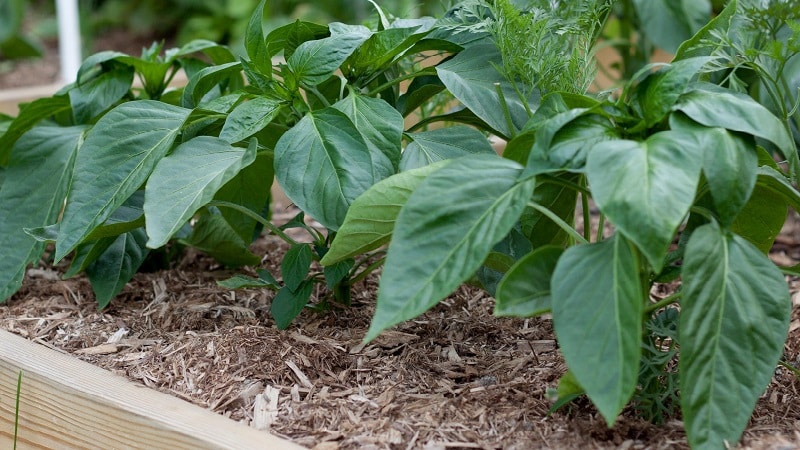
Gardener mistakes
The culture reacts even to minor deviations from the rules of agricultural technology. If the growing conditions are not met, the growth of the plant slows down and the development of the bush stops. The appearance of the leaves indicates the condition of the plant.
Pepper is a moisture-loving crop. With insufficient watering, the green mass withers, the edges of the leaves curl, the leaf dries and falls off.
If the air in the greenhouse is too dry, this will affect the condition of the foliage: it becomes deformed and becomes gray.
Some beginners believe that it is enough to create a warm and humid climate in the greenhouse without paying attention to lighting. This mistake leads to a lack of light, as a result of which the bushes grow weak, with twisted leaves and thin branches. Culture cannot stand being in the shadows and is slowly dying from it.
If tomatoes or eggplants were grown in a greenhouse in the previous season, spores of pathogenic fungi may remain in the soil, leading to damage to the pepper.
Sometimes, in order to obtain a large harvest, gardeners use mineral fertilizers beyond the norm. Pepper reacts negatively to an excess of added elements.This is reflected in the appearance of the green mass.
The appearance of the leaves also indicates a deficiency of any element. With a lack of phosphorus, the lower part of the leaves acquires a purple tint. With a lack of potassium, the leaves curl and turn yellow. If the plant does not have enough nitrogen, the leaves turn gray-green. To replenish the missing element, fertilize the leaf.
External factors
One of the external factors affecting the condition of foliage in a greenhouse is sunburn.
It occurs when condensation collects on the leaves and is exposed to sunlight. The temperature in this area of the leaf increases greatly, and dry, colorless spots form. The leaves curl and dry out. This happens especially often in low greenhouses.
Plants also get sick if soil from the area where infected plants grew was brought into the greenhouse to create beds.
If undisinfected pepper seeds were used when growing seedlings, this will also subsequently affect the health of the crop.
What to do and how to save the harvest
To treat a crop, it is necessary to establish the cause of leaf wilting. It is important to adjust the humidity and temperature in the greenhouse. The room must be regularly ventilated. Great importance is paid to the quantity and type of fertilizers applied.
The beds are periodically weeded to remove weeds and loosened to improve aeration of the root system. To prevent the appearance of insect pests and fungal infections, the crop is treated with appropriate preparations.
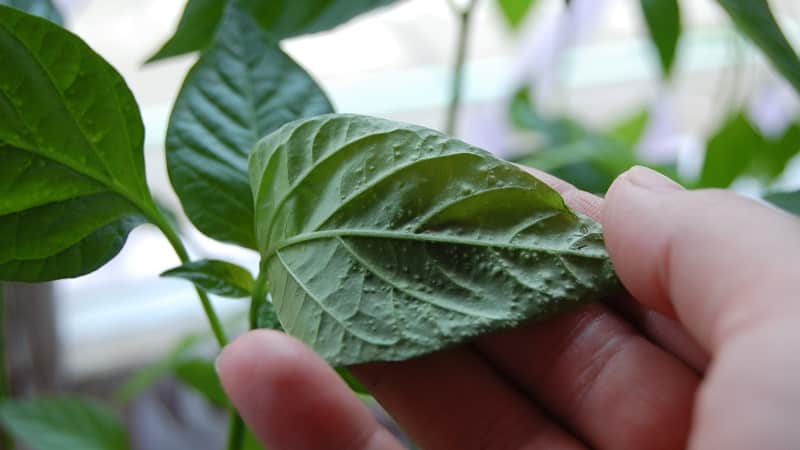
Creating favorable conditions
When creating favorable conditions in a greenhouse, great importance is given to air humidity. After planting the seedlings, humidity is maintained within 70-75%.After the seedlings get stronger and begin to grow, the air humidity level is reduced to 65-70%. Hygrometers are used to control humidity.
Pepper is a heat-loving crop. To grow it, it is necessary to maintain the temperature in the greenhouse at +23...+26°C. Pepper does not tolerate sudden changes in day and night temperatures. Therefore, if cold nights are ahead, containers with warm water are placed in the greenhouse between the rows.
Reference. When the temperature drops by 5°C, the air humidity in the greenhouse increases by 20%.
When hot weather sets in, the air in the room overheats and the leaves become lethargic. Ventilation will help reduce the temperature. In this case, it is necessary to avoid drafts, so the greenhouse is ventilated on one side.
Bushes must be protected from direct sunlight. To do this, a thin covering material is stretched under the ceiling of the greenhouse.
Correct watering regime
Pepper responds well to moisture. Watering you need to wash it early in the morning with water at room temperature. If you water during the day, the moisture will quickly evaporate. In dry, hot weather, watering is carried out in the morning and evening.
In normal weather, the crop is watered every other day. If there is a lack of moisture, the leaves curl and the plant withers. When there is an excess of moisture, fungal infections develop and the root system rots.
As the bush grows, the amount of liquid added is increased. When watering, you need to make sure that water does not get on the leaves.
Important! The main condition for watering is regularity. Uneven irrigation during the period of pepper formation leads to its deformation and cracking.
Feeding
When growing crops, special attention is paid to fertilizing.
The first feeding is carried out two weeks after planting the seedlings in a permanent place in the greenhouse. For this, organic matter is used: a solution of cow manure diluted with water in a ratio of 1:10, left for 4-5 days.
For mineral fertilizing, prepare a composition that includes 20 g of urea, 40 g of superphosphate and 30 g of potassium sulfate, diluted in a bucket of water.
Attention! It is not allowed to use mineral fertilizers that contain chlorine for fertilizing. This element has a detrimental effect on culture.
The second feeding is carried out two weeks after the first. Compost is added to complex mineral fertilizers.
For the third feeding during the formation of vegetables, potassium and phosphorus fertilizers are used.
Good results are achieved by alternating mineral and organic fertilizers.
Disease Control
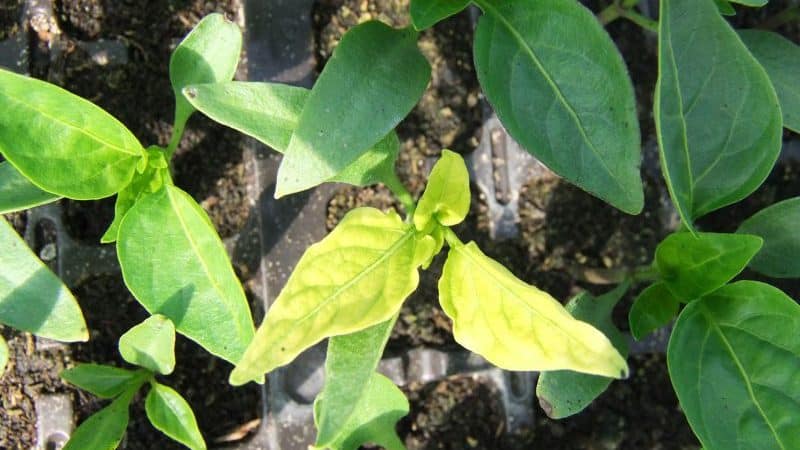
Insect pests that settle on crops become carriers of fungal infections of vegetables.
When affected by phytoplasmosis, the edges of the leaves bend upward, curl, and dry out. The bush gradually turns yellow, the fruits grow small and deformed. To prevent the disease, bushes are treated with Arrivo 2-3 times per season.
With late blight, dark spots and deformations appear on the leaves. Weeping spots form on the fruits. The plant gradually dies. At the first signs of damage, the drugs “Oxychom”, “Barrier”, “Zaslon” are used. In case of severe damage, the bush is destroyed, and neighboring plants are treated with the indicated drugs.
Fusarium wilt of peppers attacks the plant's vascular system, causing it to become blocked. The juice stops circulating through the vessels, the plant is left without nutrition and dies. To prevent the disease, seed material is soaked in Fundazol.In the initial stage of the lesion, in addition to Fundazol, the drug Topsin M is used.
Pest extermination
In the event of a pest invasion in a greenhouse, insecticides are used:
- When aphids appear, the bushes are treated with Karbofos. To prepare a working solution, 10 ml of the drug is diluted in 10 liters of water.
- To destroy a large number of spider mites, the drugs “Aktellik”, “Akarin”, “Fitoverm” are used.
Aphids, spider mites and whiteflies can also be destroyed using traditional methods, since the use of chemicals in a greenhouse is undesirable:
- Insects react poorly to a solution of laundry soap. In 5 liters it is enough to dissolve 20 g of grated soap and treat the green mass of the bush with the solution.
- To destroy whiteflies, dissolve 30 g of crushed tar soap in 500 ml of water and treat the plant.
Soap treatments are repeated after five days, since during this time new insects emerge from the larvae.
Features of the treatment of sweet bell pepper
There are several reasons why bell pepper leaves curl:
- In some cases, leaves curl if the central vein grows faster than the entire leaf blade. The leaf then takes on an irregular shape. This is due to lack of light. The defect goes away when the light in the greenhouse is adjusted.
- The leaves curl upward in a boat when there is a lack of water. This plant reduces the area of moisture evaporation. Timely watering eliminates this cause.
- If, when curling, the leaves are still covered with dark spots and dots, this indicates a viral mosaic infection. The culture is treated with a pink solution of potassium permanganate.
- With a lack of potassium, the leaves curl inward. Fertilizing with wood ash helps with this: 3 tbsp. l.pour under each bush and water the soil. Add potassium nitrate at the rate of 10 g of the drug per 5 liters of water.
Acute
When growing hot peppers, it is necessary to constantly moisten the soil and maintain the temperature at the same level. Its leaves are thin, elongated, require a lot of moisture, and when there is drought, they droop down and fall off. Hot peppers require a lot of light when grown, but not enough the ovary dies.
Preventive measures
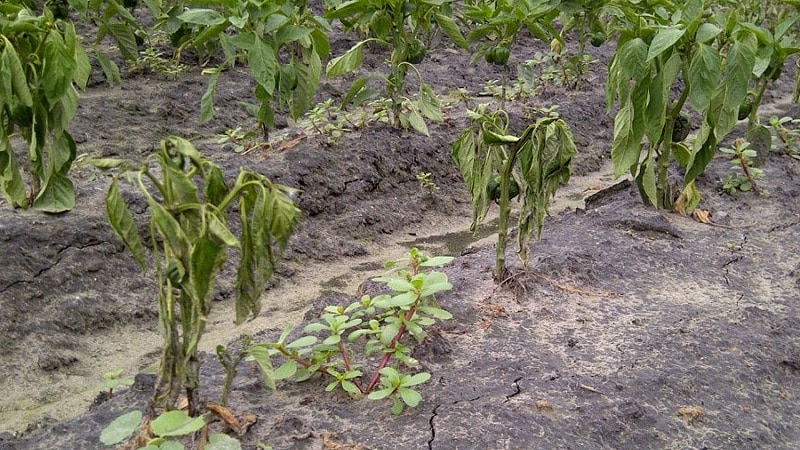
To prevent pepper diseases and pest invasions, preventive measures are taken:
- at the end of the season, carefully remove plant debris and remove 20 cm of the top layer of soil, replacing it with fresh soil;
- before sowing, seeds and soil are disinfected, the inner surface of the greenhouse is treated with antiseptic agents;
- do not allow seedlings to thicken;
- comply with the rules of agricultural technology;
- destroy pests in a timely manner.
Advice from summer residents with experience
Experienced gardeners recommend:
- Constantly inspect plants for diseases and pests. Timely treatment saves the harvest.
- For sowing, use only high-quality and processed seeds. Before sowing, soak them in the Zircon growth stimulator.
- Do not plant peppers in a greenhouse for several seasons in a row. The culture needs to change.
Conclusion
Like any plant, pepper plantings require continuous care. If agricultural practices are violated, crop development will deteriorate. It is important to monitor the temperature and humidity in the greenhouse, water regularly and on time, ventilate, feed three times without excess, and monitor symptoms of diseases. Well, let's start with seed treatment. Proper agricultural technology will protect pepper planting from many problems.